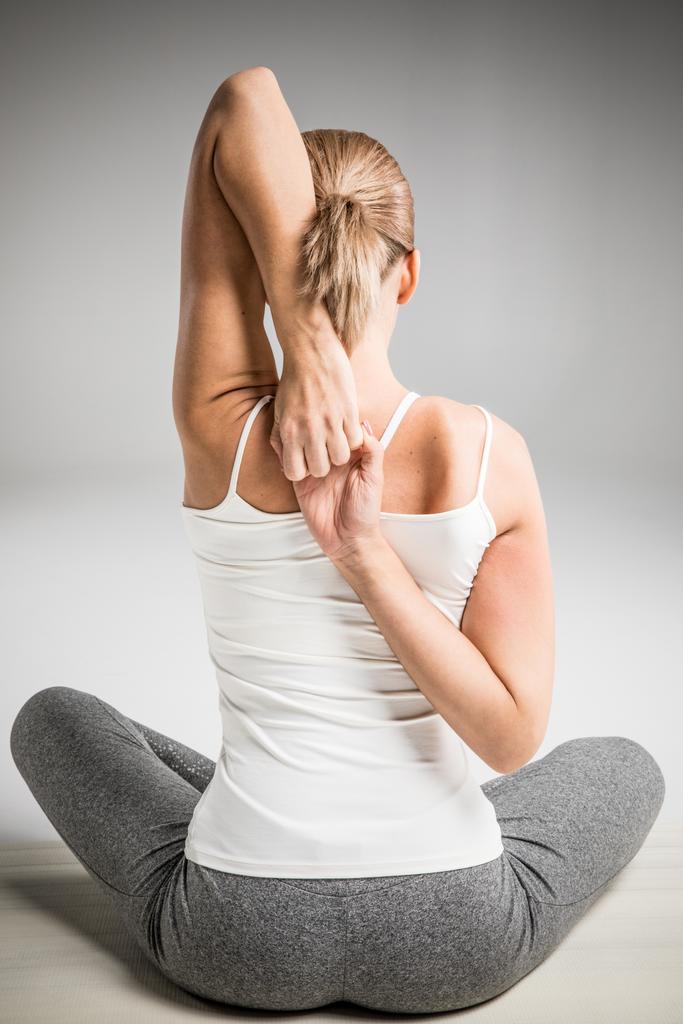You’ll find deep relief from back tension through this gentle, restorative yoga sequence that’s designed for all experience levels. Start with mindful breathing while lying on your back, then flow through gentle poses like Child’s Pose and Cat-Cow stretches, using props for support and comfort. Keep your movements slow and intentional, focusing on your breath and body awareness. By following proper alignment and post-practice care tips, you’ll uncover lasting techniques for managing back discomfort.
Key Takeaways
- Begin with mindful diaphragmatic breathing while lying down to activate relaxation and prepare the body for movement.
- Flow through gentle Cat-Cow stretches synchronized with breath to mobilize the spine and release tension.
- Use proper props like bolsters and blocks to support alignment and ensure comfort during restorative poses.
- Practice Child’s Pose with deep breathing to decompress the spine and create space between vertebrae.
- End with Happy Baby pose, incorporating gentle rocking motions to release lower back tension and hips.
Understanding Back Tension and Its Impact on Daily Life
While you might think back tension only affects a small portion of the population, it’s actually an overwhelming global health challenge that impacts hundreds of millions of people.
Your daily activities, from sitting at work to basic household tasks, can be severely disrupted by back tension.
You’re not alone in this struggle – back tension affects people of all generations and backgrounds, with nearly 40% of US adults experiencing it.
The daily impact can be profound, affecting your sleep, work productivity, and overall quality of life.
Whether you’re dealing with stress-related tension or postural strain, understanding these patterns is your initial step toward relief.
Essential Props and Setup for Your Practice
Setting up your yoga practice space with the right props can make a world of difference in addressing back tension. Your prop selection should focus on supporting your body’s needs while ensuring comfort and safety throughout your practice.
The right yoga props can transform your practice, providing essential support and comfort while helping release stubborn back tension safely.
When setting up your space, you’ll want to have these crucial items ready:
- A firm bolster and two blankets for spinal support
- Two yoga blocks and a strap for maintaining proper alignment
- A yoga wheel or tennis ball for targeted pressure release
Mindful Breathing Techniques for Deep Release
Mindful breathing serves as the foundation for releasing stubborn back tension and creating lasting relief.
Through breath awareness, you’ll learn to tap into your body’s natural relaxation response by focusing on smooth, controlled diaphragmatic expansion.
Start by lying comfortably on your back with one hand on your belly and one on your chest.
As you inhale through your nose, feel your belly rise like a gentle wave; as you exhale, let it fall naturally.
This simple practice encourages proper breathing patterns, reduces muscle tension, and calms your nervous system, making it easier to release those tight spots in your back.
Step-by-Step Gentle Back Relief Sequence
Begin your expedition to back relief with this carefully sequenced flow designed to gradually open and strengthen your entire spine.
Through gentle sequences and mindful movements, you’ll release tension layer by layer.
- Start in Child’s Pose, allowing your breath to deepen for 5-8 breaths.
- Flow through Cat-Cow stretches 3-5 times, moving with your breath.
- Shift to Tabletop position for gentle spinal waves and side stretches.
Next, ease into Happy Baby pose, gently rocking side to side.
You’ll feel your lower back melting into the mat as tension dissolves with each mindful movement.
Remember to move slowly, honoring your body’s limits today.
Modifications for Different Mobility Levels
Whether you’re recovering from injury or simply have natural mobility limitations, adapting your yoga practice is essential for a safe and effective experience.
You’ll find yoga accessibility is easier than you think with simple props and modifications. Use blocks under your hands in Low Lunge to reduce strain, or place a pillow beneath your knees in Child’s Pose for joint comfort.
For mobility adaptations that work with your body, try holding your leg instead of your foot in Head-to-Knee pose, or lift your chest slightly rather than fully in Cobra.
Post-Practice Care and Recovery Tips
Once you’ve completed your yoga flow, taking proper care of your body becomes essential for best recovery and lasting benefits.
Your post-practice routine should focus on smart hydration strategies and nutrition tips to help your muscles recover effectively.
Here’s what you’ll want to include in your recovery plan:
- Drink plenty of water or electrolyte beverages, avoiding caffeine and alcohol.
- Apply either heat therapy for muscle relaxation or ice packs if you’re experiencing inflammation.
- Consider consuming anti-inflammatory foods like turmeric tea or a protein shake within 30 minutes after practice.
Building a Sustainable Back Care Routine
Creating a sustainable back care routine through yoga requires thoughtful planning and consistent dedication to protect your spine for years to come.
Start by incorporating self care strategies like daily 10-minute micro-practices, focusing on gentle movements such as cat-cow sequences and child’s pose variations.
To build sustainable habits, listen to your body’s needs and adjust accordingly.
You’ll want to progress gradually from basic poses to more challenging ones, always prioritizing proper form over depth.
Remember to modify poses using props when needed, and maintain a consistent practice schedule that fits naturally into your daily routine, whether it’s morning stretches or evening wind-down sessions.
Frequently Asked Questions
Can I Practice Yoga for Back Tension While Pregnant?
You can safely practice prenatal yoga for back tension with proper modifications and support. Focus on gentle, safe stretches, use props when needed, and always check with your healthcare provider initially.
What Time Gap Should I Maintain Between Meals and Yoga Practice?
You’ll need to wait 1-2 hours after light meals and 3-4 hours after heavy meals for ideal yoga benefits. For quick snacks and fruits, a 30-45 minute gap is sufficient.
How Long Does It Typically Take to Notice Improvements in Back Pain?
You’ll typically notice initial pain management improvements within 3-6 months, with many experiencing relief sooner. Your recovery timeline varies based on maturity, previous injuries, and consistent practice habits.
Should I Continue Yoga Practice if I Have a Herniated Disc?
You’ll need your doctor’s approval before practicing yoga with a herniated disc. With proper guidance and yoga modifications, gentle poses may help, but avoid any movements that cause discomfort.
Can Certain Yoga Poses Worsen Existing Spinal Conditions Like Scoliosis?
Yes, certain poses can worsen scoliosis if done incorrectly. You’ll need proper scoliosis modifications and safe stretches under professional guidance to protect your spine and prevent curve progression.
Conclusion
You’ve now got the tools to release that nagging back tension through mindful movement and breath. Remember, consistency is key – even 10-15 minutes of gentle stretching each day can make a world of difference in how your back feels. Listen to your body, modify when needed, and be patient with your progress. With regular practice, you’ll develop a sustainable routine that keeps your back feeling strong and supple.



